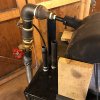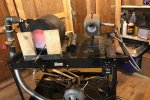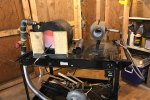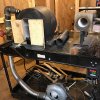DanF
Knifemaker / Craftsman / Service Provider
- Joined
- Apr 17, 2017
- Messages
- 1,465
For the past couple weeks I’ve been experimenting with my 20lb propane tank blown gas forge to see how wide a temperature range I could achieve and hold for extended periods of time.
As built, the burner nipple was 1”, and this is would mostly stay from welding temps to down around 1700*f.
I removed the 1” burner, replacing it with a 3/4” burner, and realized temps from 1900 down to around 1250*f, still too hot for what I wanted to achieve.
So, after consulting a more experienced forge builder, I dropped down to a 1/2” burner.
This gave me temps from 1900 down to 600*f. I can even “sneak” the temp down to just above 500*f, if I work at it. With the 1/2” burner I can dial in at just over a thousand degrees f with only an 11 degree difference from 3/4 of the way inside the chamber to 1/4 of the way inside the chamber. This is all manual at this point in time.
My next step will be installing everything needed for the pid to control the temperatures, which should be able to hold the temps to closer tolerances than I can manually. Realizing a +/- temp range of 5 to ten degrees will be closer than my HT oven ever has been.
As built, the burner nipple was 1”, and this is would mostly stay from welding temps to down around 1700*f.
I removed the 1” burner, replacing it with a 3/4” burner, and realized temps from 1900 down to around 1250*f, still too hot for what I wanted to achieve.
So, after consulting a more experienced forge builder, I dropped down to a 1/2” burner.
This gave me temps from 1900 down to 600*f. I can even “sneak” the temp down to just above 500*f, if I work at it. With the 1/2” burner I can dial in at just over a thousand degrees f with only an 11 degree difference from 3/4 of the way inside the chamber to 1/4 of the way inside the chamber. This is all manual at this point in time.
My next step will be installing everything needed for the pid to control the temperatures, which should be able to hold the temps to closer tolerances than I can manually. Realizing a +/- temp range of 5 to ten degrees will be closer than my HT oven ever has been.




